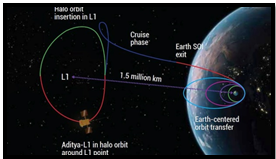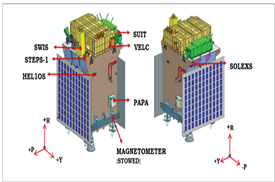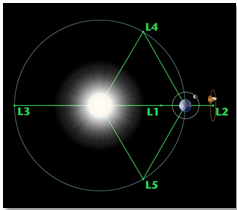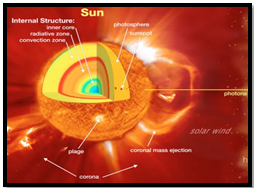HERE COMES THE SUN
Aditya-L could help unravel several mysteries of the star closest to the Earth. It’s another feather in ISRO’s cap
Relevance:
GS 3
- Science and Technology- developments and their applications and effects in everyday life.
- Achievements of Indians in science & technology; indigenization of technology and developing new technology.
- Awareness in the fields of IT, Space, Computers, robotics, nano-technology, bio-technology and issues relating to intellectual property rights.
Why in News:
Recent reports by private agencies state that fewer than half of India’s graduates were employable in 2021.
Source: Ajj tak
The Aditya-L1 mission marks a significant leap in India’s space exploration, positioning ISRO among the elite to study the Sun closely. Located at a strategic L1 point, it aims to unlock the mysteries of the solar atmosphere and influence. This mission propels India into a new era of astronomical research, promising to enhance our understanding of space weather and solar dynamics. Aditya-L1 stands as a testament to human curiosity and technological prowess in unveiling the secrets of our closest star.
About Aditya L1
- Aditya-L1 represents India’s inaugural space-based observatory-class solar mission, aimed at studying the Sun from a considerable distance of 1.5 million kilometers. It is anticipated to take about 125 days to reach the L1 point.
- Aditya-L1 follows ISRO’s AstroSat (2015) as the second mission in its astronomy observatory-class.
- The mission’s travel duration is notably shorter than India’s previous Mars orbiter mission, Mangalyaan.
- The spacecraft’s intended orbit is a halo orbit situated around the Lagrangian point 1 (L1) within the Sun-Earth system.
Seven Payloads of Aditya L1
1. Visible Line Emission Coronagraph (VLEC): For Corona/Imaging & Spectroscopy 2. Solar Ultraviolet Imaging Telescope (SUIT): Photosphere and Chromosphere Imaging- Narrow & Broadband 3. Solar Low Energy X-ray Spectrometer (SoLEXS): Soft X-ray spectrometer: Sun-as-a-star observation 4. Aditya Solar wind Particle Experiment (ASPEX): Solar wind/Particle Analyzer Protons & Heavier Ions with directions 5. High Energy L1 Orbiting X-ray Spectrometer (HEL1OS): Hard X-ray spectrometer: Sun-as-a-star observation 6. Plasma Analyser Package for Aditya (PAPA): Solar wind/Particle Analyzer Electrons & Heavier Ions with directions 7. Advanced Tri-axial High-Resolution Digital Magnetometers: In-situ magnetic field (Bx, By and Bz). |
Objectives
Objectives of Aditya L1:
- Understanding Coronal Heating and Solar Wind Acceleration: This means figuring out how the Sun’s outer layer, called the corona, gets so hot and how it produces the fast-moving solar wind.
- Understanding the Initiation of Coronal Mass Ejections (CMEs), Flares, and Near-Earth Space Weather: This goal involves studying how and why events like CMEs (powerful solar eruptions), flares (intense bursts of energy), and their impacts on space near Earth occur.
- Understanding the Coupling and Dynamics of the Solar Atmosphere: This objective aims to learn about how different parts of the Sun’s outer atmosphere are connected and how they change and interact with each other.
- Understanding Solar Wind Distribution and Temperature Anisotropy: This means investigating how solar wind (charged particles from the Sun) is spread out in space and how its temperature varies in different directions.
Significance of Aditya L-1 Mission:
- Observing Solar Activities: The mission helps us understand the Sun’s behavior and how it affects Earth. It helps in studying solar storms that can damage satellites and disrupt our technology-dependent world.
- Space Weather Prediction: Aditya-L1 aids in predicting space weather, which impacts telecommunications, navigation, air travel, power grids, and more. It enhances our ability to forecast and prepare for space weather events.
- International Leadership: India joins NASA and the European Space Agency in deploying a solar observatory. This elevates India’s status in space-based solar research.
- Halo Orbit Placement: Placing the satellite in a halo orbit outside Earth’s influence ensures stability and minimizes disturbances, making it an ideal location for solar observations.
- Scientific Discovery: Solar missions often lead to unexpected discoveries, providing new insights into the Sun’s behavior and solar wind, as seen with NASA’s Parker Solar Probe.
- Additional Advantages: The mission has broader benefits, including job creation, improved safety on Earth, and enhanced international collaboration.
Challenges:
- L1 Point Navigation: Precise navigation is required to overcome the Sun’s gravitational pull and high-speed spacecraft movement.
- Exposure to Sun’s Heat: Proximity to the Sun exposes spacecraft to extreme temperatures and radiation, necessitating advanced materials and thermal protection systems.
- Power Generation: Solar panels may struggle to generate power as they get closer to the intense sunlight near the Sun.
- Communication: Sun’s radio emissions can interfere with spacecraft communication over vast distances.
- Data Collection: Maintaining instrument accuracy in extreme conditions is challenging but crucial for reliable data collection.
Way Forward:
- Advanced Instruments: Invest in developing advanced solar observation instruments, improve data collection, precision, and instrument durability.
- International Cooperation: Collaborate with space agencies like the USA and ESA to advance solar science and technology.
- International Competition: Strive for leadership in solar science and technology to better understand the Sun and space weather.
- Education: Promote space science among the public and educational institutions to nurture future scientists and engineers.
- Funding: Ensure long-term planning and financial support for such missions by creating a supportive space policy environment.
- Data Utilization: Effectively use the data collected from solar missions to maximize scientific benefits.
Lagrange Points
Source: NASA
- Lagrange Points are specific locations in space where the gravitational forces of two substantial celestial bodies, like the Sun and Earth, counterbalance each other.
- These points allow small objects, such as spacecraft, to maintain their orbits with minimal fuel consumption.
- There exist five Lagrange Points, each characterized by unique attributes, facilitating stable orbits for smaller masses.
- In the Sun-Earth system, L1 is particularly significant for solar observations. Placing a satellite in a halo orbit around L1 offers continuous unobstructed views of the Sun, avoiding eclipses or occultation.
Associated Concepts:
· Sun’s Corona: This is the Sun’s outermost layer, where particles move at incredibly high speeds due to its high temperature. These particles can even escape the Sun’s gravitational pull. · Space Weather: It refers to changes in space’s environmental conditions, primarily influenced by activities on the Sun’s surface, such as solar wind and magnetic field variations. · Chromosphere: The chromosphere is a layer of gas above a star’s photosphere, with temperatures ranging from 6,000 to 20,000 degrees Celsius. It acts as a transition zone between the corona and the photosphere, and its temperature increases as it moves farther from the Sun. · CME (Coronal Mass Ejection): CMEs are large eruptions of magnetized plasma that originate from the Sun’s corona and travel outward into interplanetary space. · Solar Flares: Solar flares are intense bursts of radiation resulting from the release of magnetic energy associated with sunspots. They appear as bright areas on the Sun’s surface and can last from minutes to hours. · Plasma: Plasma is a high-temperature gas in which atoms are split into electrons and ions, allowing them to move independently. It represents the fourth state of matter. |
Source : Indian Express
Mains Question
Examine the significance of ISRO’s Aditya-L1 mission in enhancing our understanding of solar phenomena. Discuss the mission’s potential contributions to space weather forecasting and its implications for technological assets on Earth.

 Source: Ajj tak
Source: Ajj tak Source ISRO
Source ISRO Source: NASA
Source: NASA Source:-UCAR
Source:-UCAR

